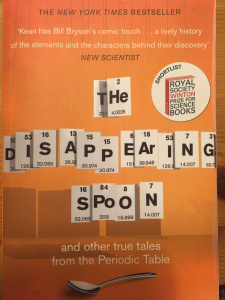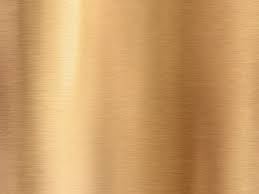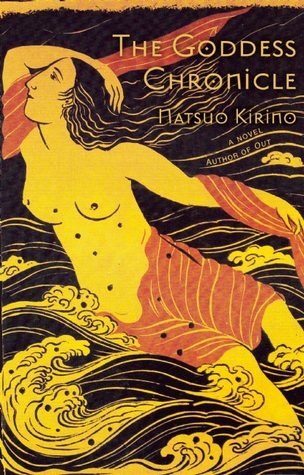“The Disappearing Spoon” is a great read for any Chemistry enthusiast which includes myself. Although I had to read this in small chunks, Sam Kean managed to make every moment enjoyable and seemed to bring to life a common-place concept which is part of every Chemist.
The book goes through most of the elements in the Periodic Table, unravelling secrets about their discoveries or any related feuds and demonstrates the powerful depth and history of the poster that hangs in every Chemistry teacher’s classroom.

For me, I think the book highlighted the fact that the scientific world is not all nice and friendly. To a certain extent, scientists are in competition with each other: who discoveries this first or who invents that. This crops up in numerous points throughout the book, as for example, having discovered elements 97 and 98, the scientists at the University of California at Berkeley named them berkelium and californium respectively. One is left to wonder whether the names give any hint at the place of discovery of the elements…
However, the fact that chemistry and the table of elements affects everyday life also becomes evident. One aspect features prominently in history and also today: money. Although a whole chapter is devoted to this topic, I’ll pick out just two little sub-stories.
The first is about the myth of Midas, a myth which I first heard of in an English reading practice for SATs at the end of my primary school years and a myth that now appears to have a plausible origin. Most people have heard of the story surrounding king Midas-he wished for whatever he touched to turn to gold. I’m not saying that that happened to the real king Midas, but there may be a reason as to why he is associated with the metal. The story starts during the Bronze Age which began in Phrygia (Midas’ kingdom which is now in Turkey) around 3000 BC. Casting bronze, which is an alloy of tin and cooper, was the thing to be done during those days and the skeleton of the king who was popularly called Midas (but was later found to be his father, Gordias) was found in his tomb in Phrygia surrounded by bronze bowls and bronze cauldrons and wearing a bronze belt. However, a number of different alloys with different ratios of metals are classified as bronze and the colour depends on the ratios of tin, copper and other elements. Coming back to Phrygia, the unique feature of metallic deposits in the area was that there was an abundance of zinc ores. Zinc and tin ores commonly commingle and can be easily mistaken for each other. The little twist here is that zinc mixed with copper forms brass…not bronze. Furthermore, the earliest known brass foundries existed in the part of Asia Minor where Midas reigned once upon a time and this little fact leads us to the heart of the tale.
 Fig. 1 Image of bronze (taken from Google).
Fig. 1 Image of bronze (taken from Google).
 Fig 2. Image of brass (taken from Google).
Fig 2. Image of brass (taken from Google).
If you compare bronze and brass (shown by figures 1 and 2), bronze is shiny with ‘overtones of copper’, whereas ‘the shine of brass is more alluring, more subtle, a little more…golden.’ And so Midas’ touch a is touch of zinc in the soil of his part of Asia Minor.
The second story is more concerned with modern-day currency. Counterfeiting is an age long problem-even Newton himself encountered it during his years at the Royal Mint of England. Nowadays, the EU uses europium as a anti-counterfeiting tool in the ink it uses on its paper notes, however I am going to explain the mechanics of this in another follow-up post because this is getting rather lengthy and I want to focus a little on light emitting and electrons in general, something which this book first introduced me to.
As a fountain pen user, the iridium story was fascinating as was the cadmium story with its links to the itai-itai disease and Godzilla. This may also be a story that I shall look into a little more.
As you can probably see from my post, this book is quite intense and cannot be read in one sitting. I found reading it in small pieces helped to try to get my head around the new concepts but it is definitely a book I would recommend to anyone interested in Chemistry to have a better understanding of the elements and collecting curious nuggets of information along the way.
Advertisements Share this:






